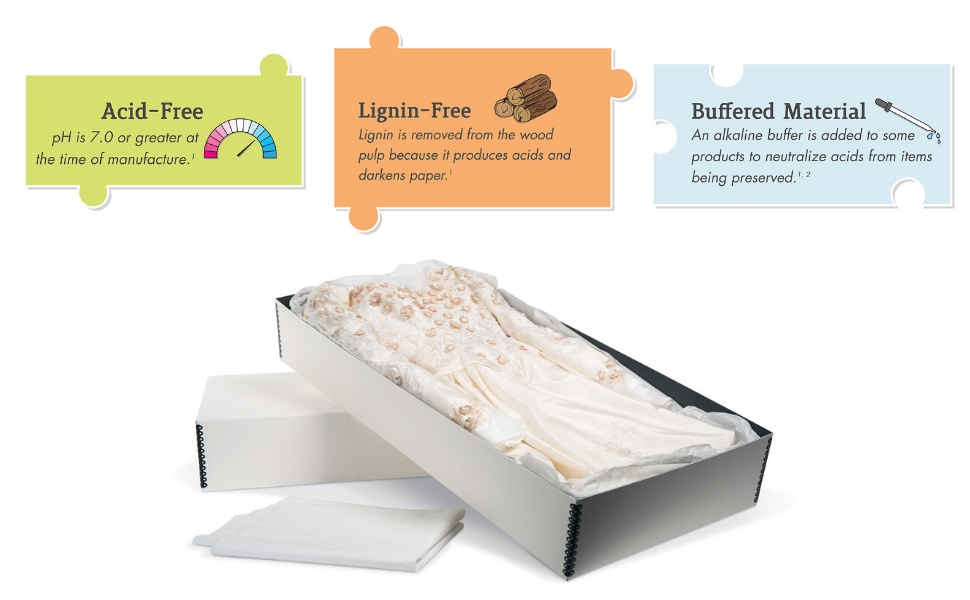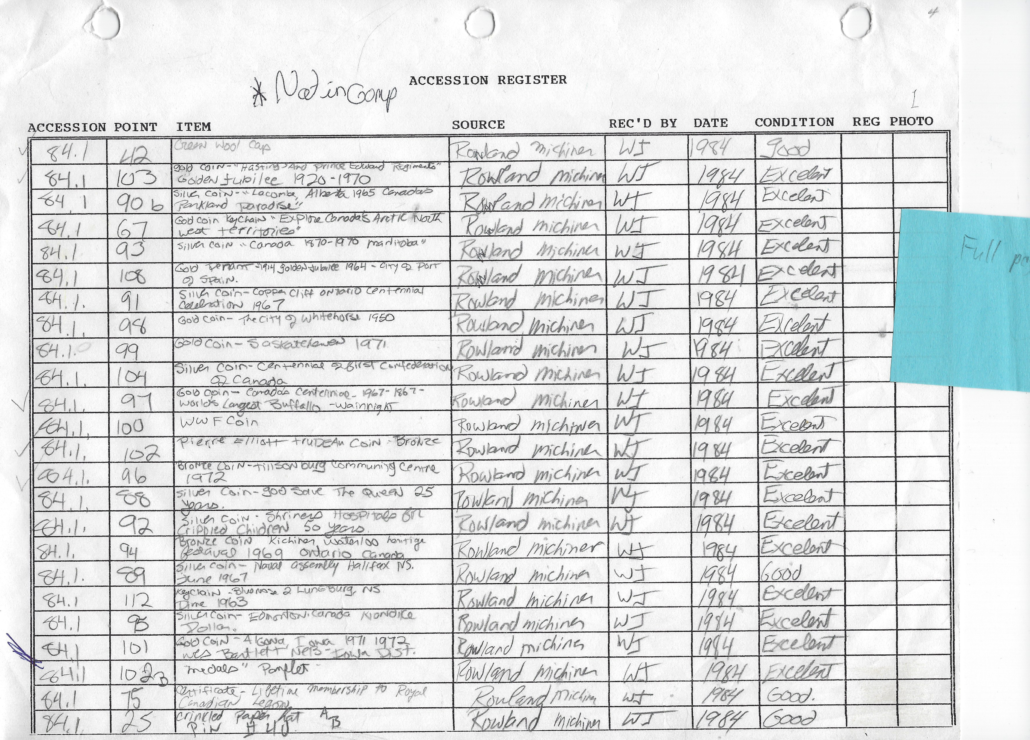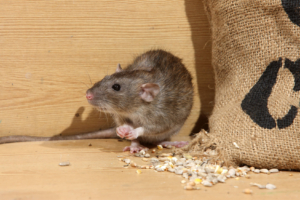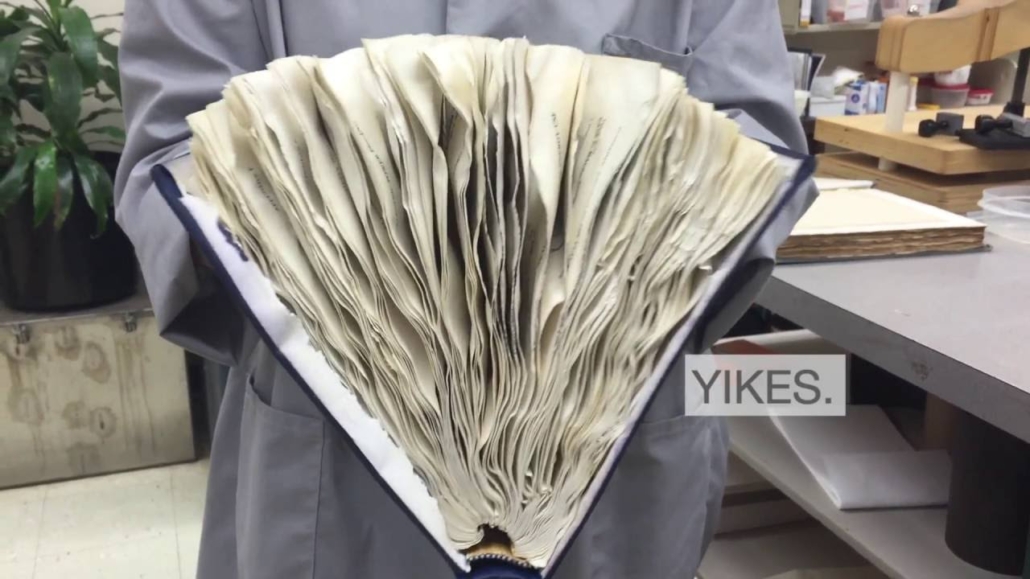Resources | The Ten Agents of Deterioration
The Archivist’s Top 10 List
Who doesn’t love a good top 10 list – Whether it’s your top 10 favourite songs, 10 best recipes, or even the top 10 things you shouldn’t do when gardening, everyone benefits from a solid top 10 list.
Did you know that museum and archives staff also have a crucially important top 10 list? It’s called the Ten Agents of Deterioration, and it’s a list of the most common things that can damage museum and archival collections. Read on to learn what they are and what you can do to protect your own collection of valuable items and family heirlooms!

1. Physical Forces
The first of the ten agents of deterioration is pretty obvious, if you drop a glass vase on the ground, it is likely to break. Vibrations can also weaken some items and too much weight on or against an object can harm it as well.
The solution?
Careful handling is one of the best ways to prevent damage due to physical forces. Use both hands when picking up an item, and make sure you know where you will set it down before you pick it up! Also, make sure you pick an item up by the sturdiest part. While it is intuitive to pick a teacup up by the handle, the handle can be the weakest part, and could break off. Always pick items up by their most robust part.
Another good preventative measure is to make sure that your items are stored in sturdy containers that can withstand some weight or pressure. Specialty archival boxes are great for this as they are acid-free, lignin-free, and can be either buffered or un-buffered!

Hollander box showcasing a wedding dress in tissue paper, Gaylord Archival
2. Thieves and Vandals
While it is not a pleasant thought, people do take things that are not theirs sometimes. More innocently, items can be misplaced, or damaged through misuse.
Museums have robust security and monitoring systems in place – but how are you to protect your items from thieves or inadvertent mini-vandals? Keeping your family heirlooms either out of sight or somewhere where you will notice if they disappear are good options. Also, keep your family photos and other heirlooms out of reach of children.
3. Dissociation
Dissociation is when an item becomes separated from information about why it is valuable.
You may think that you will always remember who is in a particular photo, who made a particular quilt, or why a framed piece of art is significant, but you would be surprised by how much knowledge is lost over the years, particularly when an elderly family member passes on. For this reason, dissociation is one of the ten agents of deterioration that can best be beaten with the careful organization of items and their associated data. In the Museum and Archives world, we know this system as an Accession Register, and it is part of a Collection Policy or Mandate that the organization follows.

Scan of Page 1 of the Original Accession Register from the Lacombe & District Historical Society, showing the first documented donations to the Collection made in 1984 by Roland Michener.
Consider attaching information about photos to them in some way. If it is a physical photograph, you can write gently on the back with an archival pencil or pen that is acid-free, permanent, and fade-proof. Do not attach adhesive labels to your items though! Improper labelling, adhesives, and non-archival pens can all damage an object.
Digital images are important but can easily become an organizational disaster if you don’t have a system for naming and tracking the files. Museums and archives use a numbering system to identify items and retain information about them. For example, if you have a photo that was taken on May 23rd, 2019, and has your parents and children in it, you could rename your digital file 2019.5.23. That way you could both keep track of when the photo was taken and link the photo to a spread-sheet with further data about who was in the photo. There are numerous ways to embed this kind of information into the metadata of your photos. It is important to find some method that works for you so the information is preserved.
For physical items like quilts, china, etc., one method would be to create and maintain a document listing your items with information about them. Alternatively, some kind of label could be attached to the items. However, if you choose to do this, make sure that the label is made of an acid-free material and will not damage the item or pull on it in any way.
4. Fire
The Station, as the Museum of the Highwood is known, reopened in May 2012 after a fire destroyed much of the building in July 2010. Eighty percent of the museum’s remaining collection was then destroyed in the 2013 flooding that decimated much of south-central Alberta that season. One of the most dangerous of the ten agents of deterioration, fire can lead to total loss and, barring the availability of a fire-proof room or vault, it is hard to guard against.

Museum of the Highwood 2010 Fire left; 2013 Flood right. Images CBC.ca
After these disasters to the Highwood, the Alberta Museums Association developed HELP! An Emergency Preparedness Manual for Museums for organizations to prepare for, respond to, and recover from emergencies.
While museums and archives often fire-proof their collections storage areas, this is not practical for your home preservation needs. If fire is a significant concern for you, consider a metal box or filing cabinet for the items that you want to protect. While this will not protect against a raging fire, it may be enough to help in a milder situation. Other simple measures include not having any of your items by open flames or stored in furnace rooms.
5. Water
The risk posed by water to paper items is perhaps the most significant as the ink can run or the item can become very fragile and tear. Non-paper items can also be susceptible to water in other ways such as staining, dye running, becoming moldy, or swelling from excess moisture. It is a good idea to never have liquids near your items, especially if they are paper-based.
What happens if you have a pipe burst or you do spill water on your family photos? All is not lost! Watch this video from the Archives Society of Alberta to learn about what you can do if a water disaster strikes.
First, you need to learn how to safely handle your wet records (click to play):

Second, you will need to learn how to properly dry your records (click to play):

6. Pests
Pests are insects and rodents that can eat holes in items, nest in them, or cause other forms of damage. If you see one pest, there are probably more, so it is better to do something soon rather than to leave the problem for later.
The best way to deal with pests is to detect them before they become a big problem – this is part of what we call an Integrated Pest Management Plan.

Successful IPM programs use this four-tiered implementation approach:
- Identify pests and monitor progress
- Set action thresholds
- Prevent
- Control
A standard mouse/rat trap will do the trick for rodents, as well as keeping an eye out for droppings. In order to detect insects, the best tools are sticky traps as they will collect insects without crushing them, allowing you to properly cross-reference the bugs on the trap to an insect identification handbook. Some insects do not pose much threat to your collection, however, some can do major damage.

Nature Museum: What’s Feasting On Your Stuff
7. Pollutants
One of the most difficult, and costly agent of deterioration to fight against is pollutants. There are different kinds of pollutants that can pose a risk to your collection.
Airborne pollutants are what most people typically think of when they think about pollution. These are very common and can be especially damaging depending on geographic location. For example if located in close proximity to a large scale polluter like a power plant, or forest fire, pollutants can pose a larger threat to a collection. This can be combatted with an HVAC system.
Pollution through contact can be a large issue for museum collections. Many items, such as plastic, wood stain, pollutants such as oils from your skin can damage the material. This is why it is important to store your material in chemically inert/acid-free storage material.

Deterioration of newspapers over time.
Some objects actually have intrinsic pollutants that are part of their makeup. For example, newspaper print has a high content of lignin, and thus will slowly break down the paper that is printed on. This is one of the most difficult pollutants to fight against, as the exposure of lignin to air and sunlight turns paper yellow and it becomes brittle. The best way to ensure the long-term stability of objects is to minimize the risk of as many agents of deterioration as possible.
8. Light
Have you ever seen a sun-bleached shirt or a piece of newspaper that was left out in the sun? Colour will irreversibly fade from items with light damage and some items, like paper, become very brittle and fragile over long-term light exposure.
However, it is not just sunlight that does this – even artificial light causes irreversible damage to items.
Archival boxes are your best friend when it comes to preventing light damage. So are unbleached cotton covers, UV-filter film on windows, acid-free paper, and dark rooms. Use all available options to keep light damage to a minimum. Consider displaying copies of photos or art rather than the originals.
When all else fails, look at where the light is strongest in a room during the course of a day, and avoid those places for your item.

Evidence of sun fading on a hardwood floor
9. Incorrect Temperature
Put simply, most items do better long-term in cooler conditions. This can slow chemical deterioration, mold growth, and other problems. More modern materials in particular benefit from colder storage. According to the Alberta Museums Association, temperatures of approximately 21 degrees Celsius meet a good balance between human comfort and the needs of collections. The Canadian Conservation Institute notes, however, that cooler is better.
10. Incorrect Relative Humidity
When the relative humidity is high, an object will swell as it absorbs moisture. When it is low, an object will shrink as it releases moisture. Fluctuations in humidity cause items to swell and contract, which can cause warping and damage of the object if it happens too quickly or frequently.
Humidity that is too high can lead to mold growth. Ideally, humidity should be between 25% and below 65%.
What to do in Alberta where the humidity drops crazy low in the winter? Consider a humidifier or even boiling a pot of water on the stove. While this should not be done right beside the objects, it can help keep the humidity in an appropriate range for items.

Humidity damaged book as viewed in the Syracuse University Libraries YouTube video.
Written by Melissa Blunden, Executive Director and Curator, Lacombe & District Historical Society.
Sources:
The Canadian Conservation Institute
Conservation Wiki
Northern States Conservation Center
Archives Society of Alberta
Standard Practices Handbook for Museums, 3rd Edition, Alberta Museums Association

